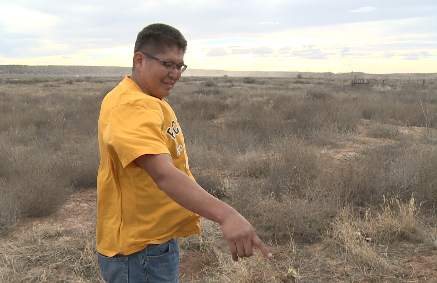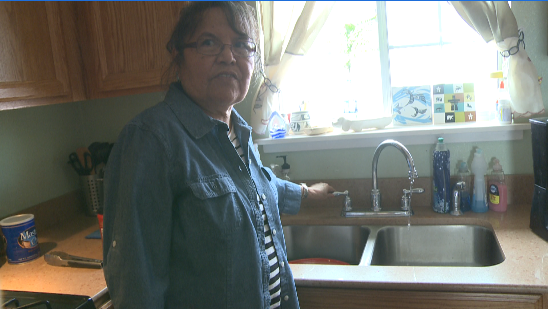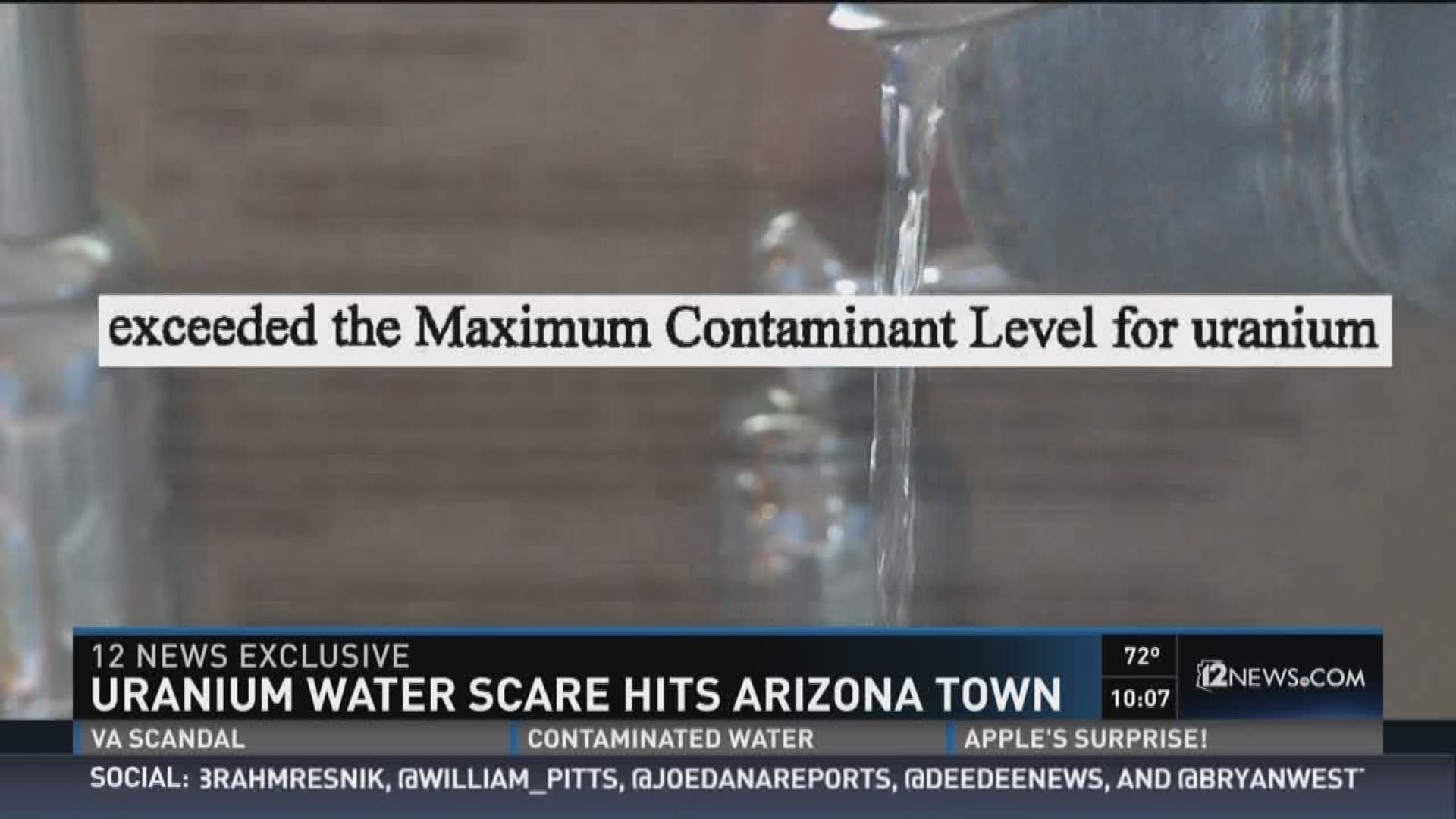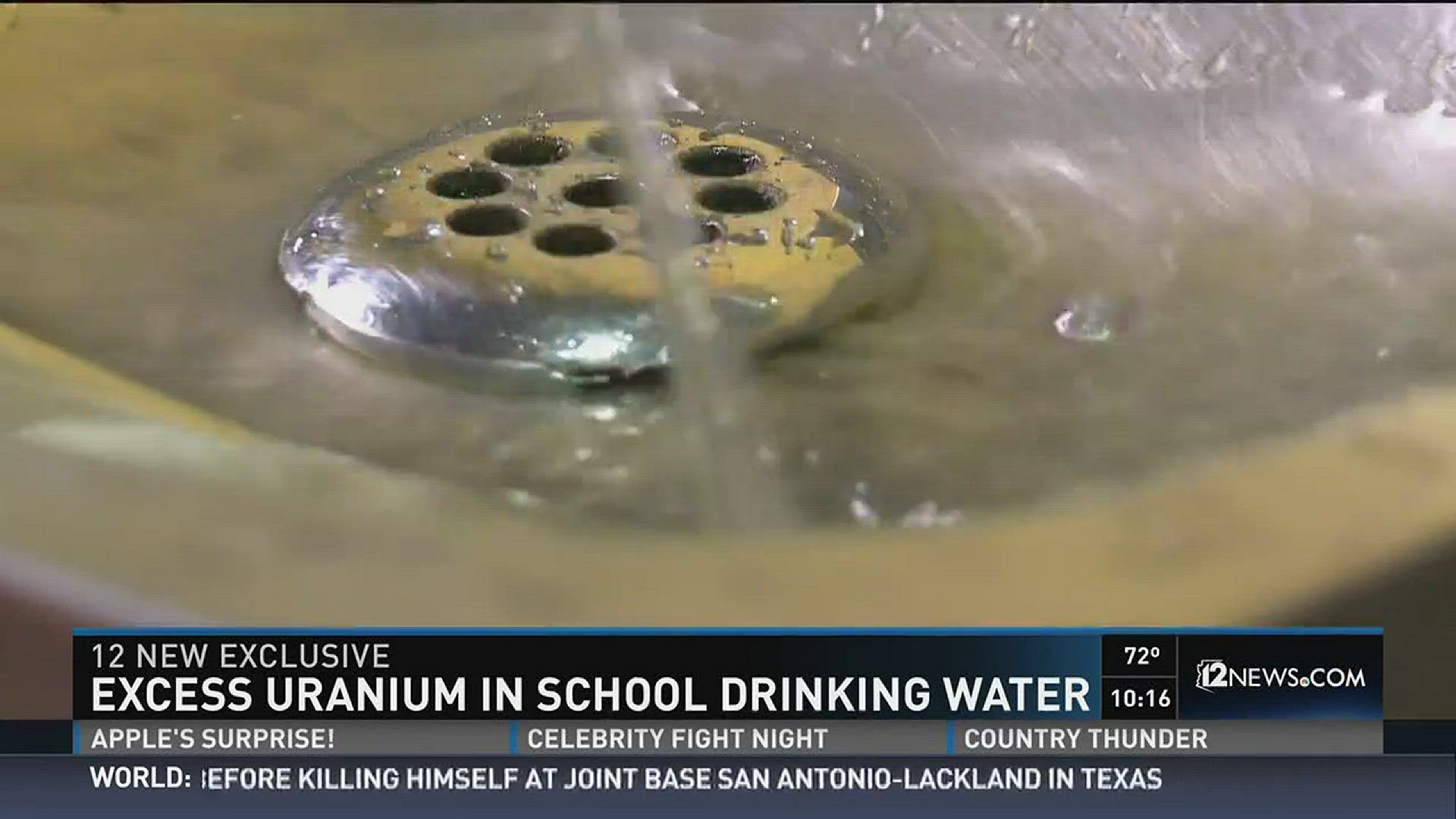SANDERS, Ariz. - A northern Arizona town’s water supply is contaminated with potentially dangerous levels of uranium, exposing hundreds of people in homes and a local school district, according to water test records.
A public notice said the contaminant levels in the water exceeds federal standards, but that the water was still safe to drink, according to the Arizona Department of Environmental Quality.
Long-term exposure to uranium can lead to kidney disease and radiation-induced cancer.
Town leaders want to know why the state agency issued the first public notice about the danger in August of 2015, despite having reports of chemical samples showing federally unsafe contamination levels more than a decade earlier.
"Folks have been using the water for so many years without being told," said Raymond Smith Jr., a community leader in Sanders. "Everybody is wondering, why are we just now getting this information?"
Sounding the alarm
The announcement by ADEQ in August appears to have been prompted by a Northern Arizona University P.H.D. student whose independent water tests in July triggered concerns.
Forty-year-old Tommy Rock is a student of earth science and environmental studies. Rock decided to examine uranium levels in the Sanders drinking water supply in July, 2015. The town sits within the jurisdiction of the state of Arizona and is located near New Mexico and the Navajo Reservation.

As the grandson of a Navajo uranium miner, Rock was probing a question linked to his own family’s legacy.
Rock grew up in Monument Valley, Utah, on the Navajo Reservation. His family tree is dotted with cancer cases about which he wonders whether they're related to decades of uranium exposure.
The reservation has more than 500 abandoned uranium mines linked to the Cold War era. Uranium contamination in homes, soil and drinking water across Navajo country is well-documented by the EPA.
“I’ve especially been interested in the relationship between the federal government and the communities affected by these mines,” Rock said. “The tribes are worse off today. There’s a lack of response, a lack of immediate action by the government and we’re still living the consequences of it.”
Uranium is a radioactive element and a building block for weapons and nuclear fuel. It’s one of 130 contaminants in public drinking water monitored by the EPA and ADEQ.
The legal threshold set by the EPA for uranium in drinking water, known as “maximum contaminant levels” (MCL), is 30 micrograms per liter, also known as 30 parts per billion.
In 1979, catastrophe struck a mine in Church Rock, New Mexico that many people believe still impacts Sanders today. A mining wastewater pond, known as a tailing, spilled into the Puerco River. The breach caused the single largest release of radioactive material in U.S. history.
The Puerco River flows downstream about 50 miles before it reaches Sanders, trickling into streams and seeping into rocky terrain.
Drinking water tests conducted in the 1980s in Sanders showed the underground wells did not appear affected. Uranium concentration was 6 to 8 parts per billion – not a cause for concern.
But by 2003, uranium levels in the town’s well water began showing up in high concentrations, ADEQ records show. A sample in 2003 showed uranium levels at 69 parts per billion. Over the span of the next 12 years, water samples totaled an average of nearly 50 parts per billion.
“You’re talking about a six- to sevenfold increase in uranium concentration over that period of time,” said Chris Shuey, a uranium impact specialist at the Southwest Research and Information Center, a nonprofit research group that analyzes public health issues in the Southwest.
Shuey’s organization assisted Rock in analyzing water samples in July.
The two men conducted water tests and researched the history of water quality in Sanders, using documents provided by the Environmental Protection Agency and the ADEQ. Records show the town’s primary water supplier, Arizona Windsong Water Company, had a long history of state and federal code violations dating back to 1990.
The company operates a 175-foot well that sits near the edge of the Puerco River.
Water companies are required to monitor contaminant levels, submit data to the state, and notify the public of water test results in annual “consumer confidence reports.” Since 1990, the company has been reprimanded for failing to submit those reports, repair structural deficiencies and gain certification.
12 News contacted the owner of Arizona Windsong Water Company, Lillie Paulsell. She declined to comment for this story and referred questions to ADEQ.
The ADEQ provided 12 News with documents detailing the agency’s efforts over the past 12 years to bring Windsong Water Company into compliance with federal testing and reporting laws, including uranium standards. The agency issued annual notices, warnings for fines and written reprimands.
Documents show Paulsell often responded to the agency by saying the company did not have funds to make system improvements. During this time, the EPA also issued at least two administrative orders against the company.
“Arizona Windsong has experienced a variety of challenges for years, including funding,” wrote ADEQ spokeswoman Caroline Oppleman in a statement to 12 News. “During this time ADEQ and EPA have been and are continuing to work with Arizona Windsong to bring this system into compliance.”
Troubled by the long history of noncompliance and their own water tests, Rock and Shuey held a Sanders town meeting in August 2015.
“It’s a sad injustice that this is once again happening to Navajo people that has been disproportionately effected in my view by this entire uranium legacy that has been going on for seventy years,” Shuey said.
Shuey’s firm, SRIC, presented to residents a slideshow regarding the history of uranium toxicity in the region and the test results of water samples in Sanders.
Their message to residents was straightforward: Local drinking water is not safe to drink, period. Showering is discouraged because of possible radon inhalation. Water temperatures should be kept cool to reduce exposure to radon.
“You know I was really irate at that time, to learn about all these violations over so many years,” said Genevieve Lee, a grandmother and lifelong Sanders resident who attended the meeting.
Over the years, Lee said she knew there were concerns about uranium toxicity in the region but she assumed the public would be notified if it was ever a problem for Sanders.
In August, ADEQ issued a public notice about the uranium levels in the water. However the agency declared the water was still safe to drink for healthy adults and children.
Then in November, ADEQ issued a revised statement that cited an opinion from the Arizona Department of Health. It advised residents not to allow children under 1 to drink the water.

“While the water being delivered to consumers by the Arizona Windsong Water Company exceeds the standard, drinking this water does not pose an immediate risk to your health. If it did, you would have been notified immediately,” the notice stated. It added that some people who drink water containing uranium in excess of the MCL “over many years may have an increased risk of getting cancer and kidney toxicity.”
The statement stresses that the risk level is low and even lower in relation to bathing and washing with the water.
“Because in Arizona’s small communities, there may only be one public water system available to provide drinking water to residents, ADEQ makes every effort to work collaboratively with these systems to achieve compliance versus shutting down a community’s sole water system, which can present a greater risk to public health,” ADEQ's Oppleman said.
Shuey and Rock insist ADEQ’s public notification is more than a decade overdue and not strong enough to protect the public.
“There’s no evidence in the record that the Arizona Department of Environmental Quality intervened when it became clear this company was not informing its customers of the quality of the water beginning in 2003,” Shuey said. “The biggest issue remains ADEQ’s failure to take responsibility for not enforcing the uranium MCL’s until last fall’s administrative order and for not informing customers about the uranium contamination.”
According to federal Safe Drinking Water Act, water suppliers are responsible to notify the public of contaminated water that exceeds EPA standards.
If a water suppler does not fulfill its obligation, the state should have at minimum an ethical responsibility to notify customers directly, Shuey said.
In an emailed statement to 12 News, Director of ADEQ Misael Cabrera said public water systems bear the responsibility to notify their customers through public notices and consumer confidence reports.
“As evidenced by the 172 documents ADEQ provided to KPNX, ADEQ has engaged with Arizona Windsong and EPA for years to resolve the system’s issue,” Cabrera wrote.
Cabrera added that beginning in June, ADEQ will put into place a new process that for the first time will directly notify customers of drinking water violations if the companies do not do it themselves.
“ADEQ is developing a process to notify consumers with timely notice about drinking water violations when public water systems fail to do so," Cabrera said.
Cabrera added that information regarding inspections and public notices of water systems is available to anyone online through the ADEQ Water Quality Division homepage.
Botched ADEQ records removed oversight from schools
The research by Rock and Shuey also exposed an alleged record-keeping snafu by ADEQ regarding the Sanders Unified School District’s water supply.
The district does not use Arizona Windsong Water Company for its water source. Rather, it manages its own water well for its estimated 800 students. Another 150 staff members reside in on-campus housing.
Prior to 2008, the school system’s water was properly classified as a “community based well.” But the state changed the school district’s water supply classification to a “non-transit well,” which did not require the same water quality testing.
“In 2008, an ADEQ inspector, no longer employed at ADEQ, reclassified the Sanders School District public water system, to a class that does not require uranium monitoring,” said Oppleman in a statement to 12 News. “In the fall of 2015, ADEQ reclassified Sanders School District water system to require uranium monitoring.”
The reclassification means that for several years, school children drank water that exceeded state and federal uranium standards without oversight by the state. There is no indication an employee for ADEQ purposely violated policies regarding classification of water systems, and records show ADEQ sent a letter to the district in 2010 notifying it of federal uranium violations.
However, to prevent any water systems from being misclassified in the future, Cabrera said ADEQ will institute a new policy to provide checks and balances for re-classification of water systems. No single ADEQ inspector will have the authority to re-classify a water system, Cabrera said.
Sanders Unified School District Superintendent Dan Hute said when he learned last year about the state misclassification, he was unsettled.

“Somewhere in the back of my mind I would probably have speculation about why it happened, but I don’t want to go there,” Hute said. Instead of focusing on why, Hute said he is determined to keep his students protected moving forward.
After Rock and Shuey notified the superintendent about the unlawful uranium levels – a 2008 ADEQ test showed uranium at 31 parts per billion and two tests conducted by Rock and Shuey in July, 2015 showed uranium levels between 34 and 37 parts per billion – Hute immediately shut off drinking fountains on campus.
He advised staff members to use the tap water sparingly and not to drink it.
“For me, it means we’re putting our future generations at risk,” Hute said.
Hute began a GoFundMe account, asking the public for funds to purchase bottled water for staff and students.
Hute said when he talked to ADEQ about the problem in August, he felt the agency was not being proactive enough.
“The notice they gave us was the water would be safe to use as long as there was not long-term exposure,” Hute said. “But what constitutes long-term exposure? We have kids who have been already attending this school for years.”
According to ADEQ, the MCL is designated to protect more susceptible individuals who drink two liters of water every day for their entire life.
But Hute does not want to take chances. He’s working with the Arizona School Facilities Board, which funds improvement projects, to come up with a solution.
What’s next?
For now, many homeowners use bottled water.
Since the August public meeting, Lee has changed her lifestyle drastically.
“We’ve decided to start trucking in water from Gallup. We also get some donations of bottled water that have been given to the town,” Lee said.
Outside water is costly. Lee says she still uses well water for washing dishes and showering. There is always uncertainty about whether her health is in jeopardy, she said.
“Everything we have comes from the environment, the soil. So we don’t really know,” she said. “I just pray. I pray a lot.”
Shutting down the Windsong Water Company for noncompliance is not an option, said Director Cabrera in his email statement.
“ADEQ’s mission is to protect and enhance public health and the environment and we have not taken a heavy-handed approach to Arizona Windsong because when a community has NO water, it faces immediate and acute public health risks. Shutting down a water system anywhere in rural Arizona when alternate water sources are not readily available is akin to asking residents of Maricopa County to stop breathing on a high pollution advisory day.”
But Shuey and Rock say something drastic is needed.
“There needs to be a new public water system for the town of Sanders and the elementary and middle school,” said Rock. “And instead of talking about it we need some action.”
The community of Sanders and the school district are looking at several possible solutions to bring drinking water into compliance with acceptable uranium levels. They include filtration systems, deeper wells, and connecting to separate water sources. But all options are costly and will likely require investments by tribal, state or federal authorities.
Some community leaders are skeptical, based on history.
“Arizona ADEQ, they’ve known this for a long time and I think we’re just too far up north out of Phoenix. If this happened in Phoenix or any other place there would be people in action,” said Wayne Lynch, a rancher who grew up in Sanders.
Cabrera said unfortunately, smaller water systems that operate in rural areas experience similar challenges with funding and system maintenance.
"It should be noted that this is something we're seeing nationally," Cabrera said.
According to news reports, the water crisis in Flint, Michigan has also caused many communities nationally to be more sensitive to problems in their own water systems. Issues that may have seemed minor in the past are getting more attention now.
The most likely solution appears to be connecting Sanders’ water system to pipes from the nearby Navajo Tribal Utility Authority (NTUA).
A hearing is scheduled in two weeks in Phoenix at the Arizona Corporation Commission to consider a takeover of the water system by the NTUA.
Raymond Smith Jr. is a Navajo Nation Council delegate.
“We’ve been talking, we’ve been meeting and it seems the state and the county won’t say 'we will help you in this matter',” Smith said. “We need progress.”
ADEQ Director Cabrera said the agency is prepared to work toward a solution.
“ADEQ and other concerned state and tribal agencies recently identified an alternative drinking water source for Arizona Windsong Water system customers,” Cabrera said. The solution he referred to is the NTUA water connection.
“This alternative source could be in place within the next few months,” Cabrera said.
Superintendent Hute said he believes ultimately the responsibility for providing safe water to Sanders lies with the Environmental Protection Agency.
“If I’m going to lay blame with anything it would be the federal government,” Hute said. "But somewhere down the line the state (ADEQ) should be working hand in hand with the federal government to clean this up. It's time they stop talking about it, took responsibility, and do something.”


